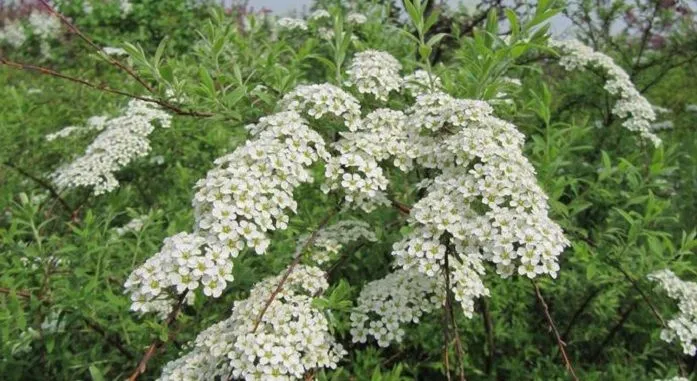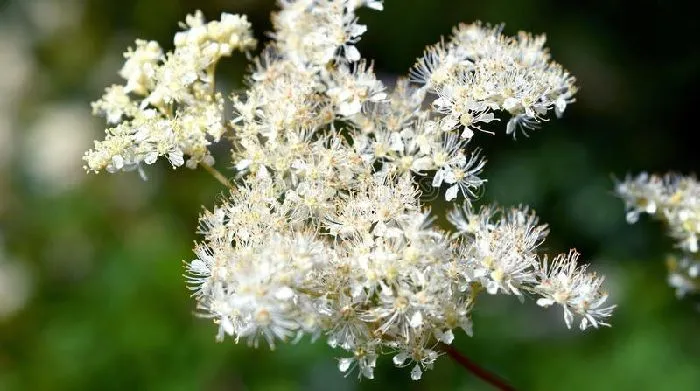If we ran into the middle of the field with meadowsweet (Filipendula ulmaria) and we were not experienced in medicinal plants, surely we would confuse it with a weed and we could even step on it.
Okay, yes, this plant does not stand out precisely for its ornamental characteristics, but it keeps a valuable chest of medicinal properties that we will delve into in this article.
And beware, that meadowsweet has a lot to do with salicylic acid and the current aspirin.
Table of Contents
Getting to know the meadowsweet plant a little more
Although it has a romantic touch, it is the common name from which this plant is known. Its main name is meadowsweet, which is scientifically classified as Filipendula ulmaria.
It is distributed practically all over Europe, so from this we can get an idea of its rusticity and adaptability. At least as far as climatological terms are concerned.
It usually inhabits swampy areas, deepened surfaces and in general, all types of soil and areas where there is abundant moisture.
Known common names
Here are some of the names that vulgarly describe this plant:
- Meadowsweet
- Queen of the meadows
- Altarcina
- Altareina
- Filipendula
- Ulmarina
Cultivation of Filipendula ulmaria
Although agronomically it only has its interest for the extraction of essential oils and their components (to create aspirin, for example), ornamentally it is not attractive. However, we give some tips on its cultivation.
They usually grow in clay soils, with good moisture holding capacity. In fact, for its growth, which is usually in swampy environments, rivers or ponds, it needs high humidity. In fact, it is a plant that indicates humidity or an area of high water concentration.
The acidity of the soil should be light, between 4.5 and 7.5, and usually demands high concentrations of nitrogen, often released by the mineralization of organic matter (from the remains of decomposition of leaves and branches).
The flowering of meadowsweet it occurs between spring (from May) and early summer (July). It usually grows in sunny environments or semi-shaded by larger trees.
It must be watered frequently and does not tolerate dry soils or low rainfall. The little access to moisture influences its growth, being a negative factor.
The propagation of the queen of the meadows is made by seed (post-flowering), although you can also perform the division of seedlings, in spring.
Other related species of the same family
Previously and within its synonymy it was also known as Spiraea ulmaria.

Pests and diseases of meadowsweet
Meadowsweet has associated a coarse number of pests and diseases, which describe the following:
Fungal diseases
- Erysiphe ulmariae (mildew)
- Cryptodiaporthe lirella
- Podosphaera aphanis
Pests (insects)
- Acleris shepherdana (affects outbreaks)
- Agromyza filipendulae (affects the leaves)
- Macrosiphum cholodkovskyi (affects leaves and flowers)
- Monochroa lutulentella (affects the roots)
Medicinal properties of Meadowsweet
Chemical composition
Some of the chemical components that characterize Ulmaria and offers its potential as a medicinal plant are the following:
- Ascorbic acid
- Coumarin
- Flavonoids (spiraeoside, rutin, hyperoside, and avicularin)
- Hydrolyzable tannins
- Salicin and salicylates
- Vanillin
- Phenolic glycosides (spierin, monotropin and gaultherin)
- MEADOWSWEET HERB – Frontier Co-op Meadowsweet (Filipendula ulmaria) is a perennial shrub and a member of the rose family. It is native to Europe and Asia, and is naturalized throughout North America. It has been used in teas and woven into bridal garlands for centuries. It is also known as the Queen of the Meadow.
1.- Analgesic effects
Among the large number of potential effects as a medicinal plant, meadowsweet has among its components salicylic aldehyde, which from it can be extracted and synthesized the aspirin, which is commonly known as aspirin.
To look for the analgesic effect offered by this component, you have to select the flowers of Filipendula ulmaria, because it is where this component is found in greater concentration.
From the main component of meadowsweet, salicylic acid was discovered in 1838 and subsequently acetylsalicylic acid in 1853. Aspirin has been one of the most widely consumed drugs in recent history, and its word derives from gender. Spiraea, which previously collected Filipendula ulmaria.
2.- Antibacterial and antiseptic effects
Some of the phenolic extracts that the queen of the meadows have been shown in the laboratory and numerous trials to have a great antibacterial effectiveness.
So far the positive results have been achieved in situations in vitro so it is early to make decisions about its potential applied in animals and humans.
3.- Anticancer effects
Although the issue of anticancer products is controversial for what the word entails, today there is great research where they give hope and good results to numerous medicinal plants.
As for meadowsweet, apolar extracts (chloroform and hexane) from the meadow queen have antiproliferative effects on B16 melanoma cells. In addition, queen extract from meadows possesses marked cytotoxicity, suppressing the growth of Raji lymphoblastoid cells human cultured at concentrations of 10 and 50 μg / ml.
The local administration of a decoction prepared from the queen flowers of the meadows resulted in a 39% decrease in the frequency of carcinoma of squamous cells of the cervix and vagina induced in mice by treatment with 7,12-dimethyl-benz(a) anthracene.
This positive response was also recorded in 32 mice (67%), including 25 cases (52%) of complete dysplasia regression, of the 48 cases of cervical dysplasia treated with ointment application courses.
No recurrence was observed in 10 completely cured patients in 12 months.
4.- Anticoagulant / antiplatelet effects
Meadowsweetcontain heparin bound to plant proteins.
This complex has anticoagulant and fibrinolytic properties of a non-enzymatic nature when administered to animals, both intramuscularly and intravenously.
The protamine sulfate can neutralize the anticoagulant activity of plant heparin. The similarity with heparin of animal origin was discovered by an examination of its molecular weight, the content of the element (sulfur, nitrogen and hydrogen), the spectral characteristics in the infrared region of the spectrum and the electrophoretic properties.
Anticoagulant effects (which can also be seen in the burdock plant)and fibrinolytics of the flowers and seeds of Filipendula ulmaria were demonstrated after oral administration of the extracts.
These components collected in the seeds of this medicinal plant exert anticoagulant effects effective both in vivo and in vitro. In this case, what interests us about this potential is that the effect it has. in vitro (in laboratory) is recurrent in vivo (applied to us).
5.- Anti-inflammatory effects
Meadowsweet has been shown to have elastase inhibitory activity. Of the 42 species of rosaceas analyzed, only the species of the subfamily Rosoideae (which includes meadows) exhibit high tannin content and elastase inhibitory activity.
To put us in background, elastase is an enzyme that is responsible for degrading the elastic fibers of our muscles as a means of response to a stimulus, causing muscle and joint inflammation.
Its inhibition or reduction in person causes inflammation to be reduced. This, added to the analgesic activity that we have commented on in point 1, make the queen of the meadows a strong ally against muscle aches and inflammations.

6.- Antioxidant effects
Some of the natural extracts of meadowsweet (especially related to phenolic compounds), have a great antioxidant power. This has been discovered from a chemiluminescence analysis (checking the activation of different cellular regions of our body).
To the extent that the use of Filipendula ulmaria as a food preservative, for example, of margarine.
7.- Antiulcerogenic activity
From the decoction (100 or 200 grams per liter of water) of meadowsweet flowers reduced the ulcerogenic action of procedures such as pylorus ligation or aggressive medications that can cause stomach ulcers.
For example, the use of salicylic acid in high amounts and can often cause these types of ulcers that are reduced with the decoction of the flowers of Filipendula ulmaria. It even promotes the healing of chronic stomach ulcers, which can happen in alcoholic people.
8.- Reduction of uric acid
Recent studies are being carried out where an infusion consumption of this plant reduces the accumulation of uric acid in the extremities (especially in the fingers) and facilitates their expulsion. Therefore it is an effective remedy to reduce the problems derived from gout.
Contraindications of the queen of the meadows
Because of its salicylate content, it should not be administered to people sensitive to this aspirin-related compound.
Likewise, in people with gastrointestinal bleeding, it is highly recommended to consult with a doctor, since the salicylate content can aggravate the problem.

